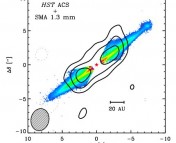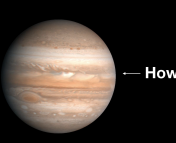Authors: Henrique Reggiani, Kevin C. Schlaufman, Brian F. Healy, Joshua D. Lothringer, and David K. Sing
First Author’s Institution: The Observatories of the Carnegie Institution for Science
Paper Status: Accepted for publication in The Astronomical Journal [open access]
H2O vs CO
There are many ways to study planet formation, including looking at a planet’s interaction with its protoplanetary disk, a planet’s interaction with other planets and/or stars that pass near the planet, or a planet’s chemistry. Today’s authors focus on planetary chemistry. By examining the abundance of various chemical elements in a giant planet’s atmosphere, it is possible to determine where the planet formed in its parent protoplanetary disk. Most astronomers investigate water (H2O) and carbon/oxygen (C/O) abundance. There is a region in a protoplanetary disk where water ice accumulates called the H2O ice line (or the snow line). CO2 is, on the other hand, solid ice beyond the snow line. C/O abundance ratios could be attributed to either the formation of a planet along the CO2 or CO ice lines, or to the planet accreting carbon-rich grains inside the H2O ice line. Today’s paper focuses on analyzing the oxygen and carbon abundances for the planet WASP-77 A b in an effort to study its formation.
Know your star!
If you want to know more about a planet, you need to learn about its star first. That’s why an important part of the paper discusses how the authors investigated the stellar parameters for WASP-77 A using photometric, astrometric, and spectroscopic data. Those parameters include its mass, radius, effective temperature, surface gravity, and iron abundance. The authors infer the stellar parameters using different techniques. Luckily, they didn’t have to reinvent the wheel, because other astronomers have created a number of open software packages that make all of this inference and analysis easier (usually, paper authors acknowledge such packages at the end of the paper). As you might have guessed, the authors of today’s papers were not the first to infer stellar parameters for WASP-77 A. However, you, just like the authors of today’s paper, would want to get the stellar parameters from the data yourself, and compare them with other studies. Furthermore, the authors argue that the inferred stellar parameters are good for planet atmospheric characterization only if the produced oxygen and carbon abundances can describe stellar mass and radius, as well as the planet parameters. In Figure 1, you can see their inferred chemical abundances for the star WASP-77 A compared to other similar stars from the GALAH survey. The white circles show where the star is located in the abundance space, and darker colors indicate that a chemical is more abundant. The authors find an “excellent agreement” between their parameters and those inferred in other papers.
About spectroscopy
Spectroscopy is the interaction of electromagnetic radiation with different substances. In the process of this interaction, we receive information both about the light itself and about the substance. By analyzing the spectral lines from a substance, one can discover what atoms and molecules it consists of and how these atoms and molecules interact with each other. The simplest case is the spectra of atoms and ions (for example, atomic hydrogen). These spectra are relatively easy to analyze and represent a set of narrow spectral lines. If you are studying the chemical abundances in astronomical objects, you are most certainly using spectroscopic data, just like the authors of this paper! Using, the atomic data, they can do the inference on the chemical abundances of different chemical elements (e.g. oxygen, carbon, etc.). Their inference on oxygen and carbon abundances reports even better confidence levels than in the previous study.
So what can we say about the planet?
It is not simple to relate a planet’s atmospheric carbon and oxygen abundances to where it formed in its parent protoplanetary disk. However, here is where the star comes in! If we know the chemical abundance of a star, then we also have an idea about the chemical composition of its planet. As the authors discovered, WASP-77 A b has significantly more carbon and oxygen than its host star; therefore it has a higher C/O abundance ratio, so the authors deduce that the planet formed outside of its parent protoplanetary disk’s H2O ice line. The authors also predict that WASP-77 A b underwent pebble accretion followed by the migration after the protoplanetary disk dissipated. So, this way chemistry becomes a tool to learn the history of the planetary system!
Featured image credit: makeameme.org
Astrobite edited by Catherine Clark




